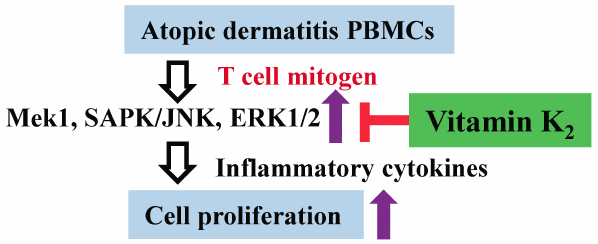- 著者
- Hisashi Kawashima Masahiro Kimura Shinichiro Morichi Shigeo Nishimata Gaku Yamanaka Yasuyo Kashiwagi
- 出版者
- National Institute of Infectious Diseases
- 雑誌
- Japanese Journal of Infectious Diseases (ISSN:13446304)
- 巻号頁・発行日
- pp.JJID.2019.541, (Released:2020-06-30)
- 参考文献数
- 19
- 被引用文献数
- 2 2
Low levels of blood vitamin D have been reported in children who have frequent respiratory tract infections. We measured serum concentrations of 25-hydroxy (OH) vitamin D in Japanese infants less than 3-months old infected with respiratory syncytial virus (RSV). Serum levels of 25-OH vitamin D of the 10 infants, excluding those with underlying diseases, were between less than 4 to 29.8 ng/mL. In 8 out of 10 subjects (80.0%), serum 25-OH vitamin D levels were less than 20 ng/mL. There was no statistically significant association between levels of 25-OH vitamin D and age, duration of admission, respiratory severity score, white blood cell count, blood gas levels, and NT-proBNP levels. Levels of serum 25-OH vitamin D in children who required hospitalization owing to RSV infection were low, indicating deficiency. These results suggested that vitamin D deficiency affects the susceptibility to RSV infection, but not the severity of the RSV respiratory infection.
- 著者
- Meiyu Zhang Taro Miura Shunsuke Suzuki Masako Chiyotanda Sachiko Tanaka Kentaro Sugiyama Hisashi Kawashima Toshihiko Hirano
- 出版者
- The Pharmaceutical Society of Japan
- 雑誌
- Biological and Pharmaceutical Bulletin (ISSN:09186158)
- 巻号頁・発行日
- vol.44, no.1, pp.7-17, 2021-01-01 (Released:2021-01-01)
- 参考文献数
- 40
- 被引用文献数
- 3 4
Vitamin K2 is suggested to have a suppressive effect on the peripheral blood mononuclear cells (PBMCs) of pediatric atopic dermatitis patients. We examined the molecular targets of vitamin K2 to suppress proliferation and cytokine production in T-cell mitogen-activated PBMCs of atopic dermatitis patients from the viewpoint of mitogen-activated protein kinase signaling molecules. The study population included 16 pediatric vitamin K2 patients and 21 healthy subjects. The effect of vitamin K2 on concanavalin A-activated PBMC proliferation was evaluated by 3-(4,5-dimethylthiazol-2-yl)-2,5-diphenyltetrazolium bromide (MTT) and cell counting assays. T-helper (Th)1/Th2/Th17 cytokine profiles in plasma and PBMC-culture supernatants were analyzed by a cytometric beads array assay. Mitogen-activated protein kinase signaling molecules in concanavalin A-activated PBMCs were examined by enzyme-linked immunosorbent assay (ELISA) assays. At 10–100 µM, vitamin K2 significantly suppressed the proliferation of mitogen-activated PBMCs derived from atopic dermatitis patients and healthy subjects (p < 0.05). The interleukin (IL)-10 concentrations in plasma and the PBMC culture supernatants of atopic dermatitis patients were significantly higher than those of healthy subjects (p < 0.05). The IL-2 concentrations in the culture supernatants of atopic dermatitis PBMCs were significantly lower than those of healthy PBMCs (p < 0.05). Vitamin K2 significantly inhibited the IL-17A, IL-10, and tumor necrosis factor α (TNF-α) production (p < 0.05), and increased the IL-2 production (p < 0.01) in the culture supernatant of atopic dermatitis PBMCs. At 10–100 µM, vitamin K2 markedly decreased the of Mek1, extracellular signal-regulated kinases (ERK)1/2 mitogen-activated protein kinase, and SAPK/c-Jun N-terminal kinase (JNK) expression in atopic dermatitis PBMCs (p < 0.05). Vitamin K2 is suggested to attenuate activated T-cell immunity in atopic dermatitis patients through the inhibition of mitogen-activated protein kinase-Mek1-ERK1/2 and SAPK/JNK signaling pathways.
